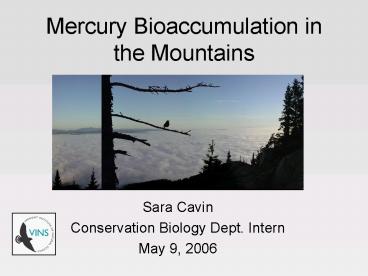Mercury Bioaccumulation in the Mountains - PowerPoint PPT Presentation
1 / 23
Title:
Mercury Bioaccumulation in the Mountains
Description:
Emissions of mercury from industrial sources. Mercury ... Mercury cycling in lake algae ... insectivore, breeds in coniferous forests above 900m. ... – PowerPoint PPT presentation
Number of Views:34
Avg rating:3.0/5.0
Title: Mercury Bioaccumulation in the Mountains
1
Mercury Bioaccumulation in the Mountains
- Sara Cavin
- Conservation Biology Dept. Intern
- May 9, 2006
2
Mercury Cycle
Emissions of mercury from industrial sources
Mercury deposition to forests
Hg0
deposition to lake and watershed
Methylation by bacteria
Mercury methylation in wetlands and sediments
Mercury cycling in lake algaeplanktonfishbirds
MeHg
Mercury uptake by humans and wildlife through
fish consumption
Uptake via trophic pathways
Figure derived from Evers (2005)
3
Mercury cycle in forests
4
Methylmercurywhat is the problem?
MeHg
Maslowski Photo
- Hg is naturally converted to MeHg
- MeHg is a neurotoxin
- MeHg bioaccumulates
- Studies looking at aquatic ecosystems
- What about the mountains/forests?
5
Total Estimated Hg Deposition
- Mountains have high Hg deposition rates
- Adequate indicator species would be
mountain-habitat specialist - Bicknells Thrush insectivore, breeds in
coniferous forests above 900m. - migrant species of highest conservation
priority in the Northeast
NH
VT
From Miller et al. (2005)
6
GIS model of Bicknells Thrush habitat
NH
VT
From Miller et al. (2005)
7
Modeled atmospheric Hg deposition (µg/m2/yr) for
Mansfield and Stratton
From Miller et al. (2005) and Rimmer et al. (2005)
8
Hg levels in forest litter and vegetation
Vegetation sampled on Stratton Mtn, VT
Relationship between modeled litterfall Hg and
blood Hg levels in Bicknells Thrush across 21
clustered mountaintops. (From Rimmer et al 2005)
9
Invertebrates from Stratton Mtn,
2004-5Spiders may comprise a main part of
Bicknells diet in early summer. Observations
show diet shifts to Lepidopteran larvae during
nesting in mid-summer.
10
Mercury in Bicknells Thrush
11
Mercury effectsstudies of Common Loon
- Lower reproductive success
- Altered chick behavior
- Decreased nest attendance disrupted hormone
levels
Increased feather asymmetry
From Evers et al. 2004
12
Might we see FA increases in Bicknells Thrush?
FA as proxy for developmental stability
Multiple (11) measurements of single feather pair
and associated SD.
13
More data from VINS biologists and others will
shed light on the impacts of methylmercury
The growing database for Bicknells Thrush shows
promise for assessing Hg exposure in breeding
range, and in wintering grounds
14
Mercurywhere does the problem lie?
- No adequate regulations on major Hg source
- U.S. government
- Globally
15
Mercury regulation in the U.S.? the 1990s
- Clean Air Act1990 Amendments
- Mercury (Hg) listed as hazardous air pollutant
- 1990s EPA rules reduced incinerator emissions
- 2000 EPA found it necessary to regulate Hg from
coal-fired power plants using maximum achievable
control technology (MACT)
16
Mercury regulation in the U.S. ? 2000-present
- 2003 EPA softened its stance on Hg
- Favored cap-and-trade program over MACT
- 2005 EPA passed Clean Air Mercury Rule
- Uses cap-and-trade instead of MACT
- Expected reductions will not be achieved until
2018
- Currently NE States (including VT) have taken
EPA to court for violating Clean Air Act
obligations
17
Mercury is a global issue
EPA estimates
- Total global emissions 5,500 tons/year
- Anthropogenic component 70
- U.S. emissions low 158 tons/year
- BUT 60 of Hg depositions in New England come
from domestic sources.
- What do we know about the wintering grounds?
18
Blood Hg levels in Bicknells Thrush in wintering
(left) and breeding range (right)
19
Mercury on the Wintering Grounds?
From www.falconbridge.com
Prevailing winds
20
Protecting Bicknells (and others) outside the
U.S.
- More study to look at sources of Hg in birds
- Pressure on governments and industries
- Inco of Canada owns facility in Bonao, DR and
some in Canada regulated under different laws - VINS work with others might help increase
pressure to reduce mercury emissions in wintering
grounds
21
Summary
- Anthropogenic mercury pollution is pervasive
- Bicknells Thrush is an indicator species for
mercury contamination in mountain forests - Studies show MeHg accumulation in forest
ecosystems - Hg increases up forest food webs
- Hg body burdens increase with age
- Higher blood Hg levels in wintering Bicknells
Thrushes - Regulations of mercury emissions are important
domestically (esp. for New England) and globally
(need to study Hg sources in wintering grounds)!
22
Acknowledgements
- Kent McFarland
- Chris Rimmer
- VINS staff, Woodstock
- Craig Pease
- VLS Environmental Law Center
23
References
- Evers, David C. 2005. Mercury Connections the
extent and effects of mercury pollution in
northeastern North America. Biodiversity Research
Institute. Gorham, ME. 28 pp. - Evers, D.C., O.P. Lane, L. Savoy, and W. Goodale.
2004. Assessing the impacts of methylmercury on
piscivorous wildlife using a wildlife criterion
value based on the Common Loon, 1998-2003. Report
BRI 2004-05 submitted to the Maine Dept of
Environmental Protection. Biodiversity Research
Institute, Gorham, Maine. - Miller, E.K., A. Vanarsdale, G.J. Keeler, A.
Chalmers, L. Poissant, N.C. Kamman, and R.
Brulotte. 2005. Estimation and mapping of wet and
dry mercury deposition across northeastern North
America. Ecotoxicology, 14, 53-70. - Rimmer, C.C., K.P. McFarland, D.C. Evers, E.K.
Miller, Y. Aubry, D. Busby, and R.J. Taylor.
2005. Mercury concentrations in Bicknells thrush
and other insectivorous passerines in montane
forests of northeastern North America.
Ecotoxicology, 14, 223-240. - U.S. EPA, Mercury Study Report to Congress 0-1
2-5 (1997) EPA 452-R-97-003.

